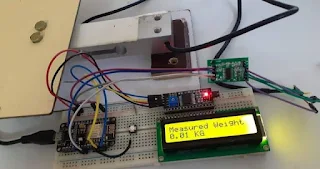IoT Weighing Scale with HX711 Load Cell & ESP8266
IoT Weighing Scale with HX711 Load Cell & ESP8266
#cs_projects #IoT
 |
image credit: how2electronics.com |
In this project we will make an IOT Based Weighing Scale with HX711 Module Load Cell & NodeMCU ESP8266. The load cell will be capable of measuring any weight up to 40KG. We will display the measured weight in Blynk Application and also monitor the weight data remotely on Thingspeak Server.
Overview
In this IoT Project we are interfacing 40Kg load cell to the NodeMCU ESP8266 using the HX711 Load cell amplifier module. HX711 is a precision 24-bit analog to digital converter (ADC) designed for weighing scales and industrial control applications to interface directly with a bridge sensor. The HX711 load cell amplifier is used to get measurable data out from a load cell and strain gauge.
The electronic weighing machine uses a load cell to measure the weight produced by the load, here most load cells are following the method of a strain gauge, Which converts the pressure (force) into an electrical signal, these load cells have four strain gauges that are hooked up in a Wheatstone bridge formation.
We will make a Weighing Scale Machine which can measure weights up to higher-value like 40KG. We need to calibrate the load cell and find the calibration factor. Once the calibration is done, we can include that factor in our code. Thus this will make the scale precise and accurate. The greater is the mass the greater the error. So we will try to remove the error from the weighing scale. We will finally display the measured weight in the 16x2 I2C LCD Display. We will send the so obtained weight value on the IoT Cloud platform called Blynk Application. Thus, weight can be monitored from any part of the world simply by observation on the Blynk app dashboard. We will also send the data on another IoT platform called Thingspeak. The graphical and numerical analysis of weight will be done in Thingspeak.
You can follow our previous post in case you want to make a Simple Weight Measuring Scale.
1. Low-Value Weight Measurement upto 10 KG
2. High-Value Weight Measurement upto 40 KG
Bill of Materials
Following are the components required for this IoT Weighing Scale Project. All the components can be easily purchased from Amazon. The component purchase link is given below.
1 NodeMCU ESP8266-12E Board 1 https://amzn.to/2LbvQIa
2 LCD Display 16X2 I2C LCD Display 1 https://amzn.to/2WBmQRP
3 Load Cell 5-40 Kg Load Cell 1 https://amzn.to/39s8CYz
4 HX711 24 Bit Amplifier Module 1 https://amzn.to/2Srbz4z
5 Push Button Push to On Reset Tact Switch 1 https://amzn.to/2UArPmG
6 Connecting Wires Jumper Wires 10 https://amzn.to/2L8Xc1p
7 Breadboard - 1 https://amzn.to/2YM6YyS
Load Cell
A load cell is a type of transducer, specifically a force transducer. It converts a force such as tension, compression, pressure, or torque into an electrical signal that can be measured and standardized. As the force applied to the load cell increases, the electrical signal changes proportionally. Load cells are used to measure weight.
40KG Load Cell
Load cells generally consist of a spring element on which strain gauges have been placed. The spring element is usually made of steel or aluminum. That means it is very sturdy, but also minimally elastic. As the name “spring element” suggests, the steel is slightly deformed under load, but then returns to its starting position, responding elastically to every load. These extremely small changes can be acquired with strain gauges. Then finally the deformation of the strain gauge is interpreted by analysis electronics to determine the weight.
Load Cell
A load cell is a type of transducer, specifically a force transducer. It converts a force such as tension, compression, pressure, or torque into an electrical signal that can be measured and standardized. As the force applied to the load cell increases, the electrical signal changes proportionally. Load cells are used to measure weight.
40KG Load Cell
Load cells generally consist of a spring element on which strain gauges have been placed. The spring element is usually made of steel or aluminum. That means it is very sturdy, but also minimally elastic. As the name “spring element” suggests, the steel is slightly deformed under load, but then returns to its starting position, responding elastically to every load. These extremely small changes can be acquired with strain gauges. Then finally the deformation of the strain gauge is interpreted by analysis electronics to determine the weight.
Read full information on : Source ©
How2electronics.com << click here
Full diagrams and details available.


Comments
Post a Comment
Please write your comments, suggestions and feedback.